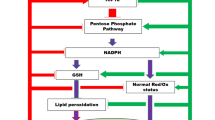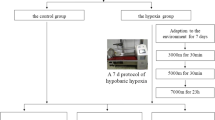Abstract
Our previous study showed that pretreatment with 5-hydroxymethyl-2-furfural (5-HMF) led to protection against hypoxic injury via a p-ERK-mediated pathway in vitro. Whether the protection of 5-HMF against hypoxia is effective in vivo is unknown. The present study is aimed to verify the role of 5-HMF in acute hypobaric hypoxia using Kunming mice as an in vivo model and further investigate the underlying mechanisms. Mice pretreated with or without 5-HMF for 1 h were exposed to acute hypobaric hypoxic condition for 6 h and then the survival time, the survival rate, the permeability of blood–brain barrier (BBB), the histological analysis in hippocampus and cortex, and the phosphorylation level of mitogen-activated protein kinases (ERK, JNK, and p38) were investigated. The results showed that 5-HMF significantly increased the survival time and the survival rate of mice. Accordingly, pretreatment with 5-HMF markedly attenuated acute hypobaric hypoxia-induced permeability of BBB (P < 0.01). In addition, the cellular damage extent of the hippocampus and the cortex induced by hypoxia for 6 h was also attenuated by pretreatment with 5-HMF, especially in the hippocampus CA1 region. Furthermore, the activation of ERK rather than JNK and p38 was involved in the protection of 5-HMF against acute hypobaric hypoxia. In summary, 5-HMF enhanced the survival capability of mice and decreased acute hypoxic damage to the brain, which may be associated with the effects on BBB and p-ERK.






Similar content being viewed by others
Abbreviations
- 5-HMF:
-
5-Hydroxymethyl-2-furfural
- MAPK:
-
Mitogen-activated protein kinases
- BBB:
-
Blood–brain barrier
- HE:
-
Hematoxylin and eosin
- ERK:
-
Extracellular signal regulated kinases
- JNK:
-
c-Jun N-terminal kinases
- AMS:
-
Acute mountain sickness
- HACE:
-
High-altitude cerebral edema
- HAPE:
-
High-altitude pulmonary edema
References
Abdulmalik O, Safo MK, Chen Q, Yang J, Brugnara C, Ohene-Frempong K, Abraham DJ, Asakura T (2005) 5-Hydroxymethyl-2-furfural modifies intracellular sickle haemoglobin and inhibits sickling of red blood cells. Br J Haematol 128:552–561
Beaumont A, Marmarou A, Hayasaki K, Barzo P, Fatouros P, Corwin F, Marmarou C, Dunbar J (2000) The permissive nature of blood brain barrier (BBB) opening in edema formation following traumatic brain injury. Acta Neurochir Suppl 76:125–129
Cagnol S, Chambard JC (2010) ERK and cell death: mechanisms of ERK-induced cell death—apoptosis, autophagy and senescence. FEBS J 277:2–21
Choi CW, Jung HA, Kang SS, Choi JS (2007) Antioxidant constituents and a new triterpenoid glycoside from Flos Lonicerae. Arch Pharm Res 30:1–7
Cross TG, Scheel-Toellner D, Henriquez NV, Deacon E, Salmon M, Lord JM (2000) Serine/threonine protein kinases and apoptosis. Exp Cell Res 256:34–41
Davis RJ (2000) Signal transduction by the JNK group of MAP kinases. Cell 103:239–252
Fischer S, Wobben M, Marti HH, Renz D, Schaper W (2002) Hypoxia-induced hyperpermeability in brain microvessel endothelial cells involves VEGF-mediated changes in the expression of zonula occludens-1. Microvasc Res 63:70–80
Gallagher SA, Hackett PH (2004) High-altitude illness. Emerg Med Clin North Am 22:329–355
Johnson GL, Lapadat R (2002) Mitogen-activated protein kinase pathways mediated by ERK, JNK, and p38 protein kinases. Science 298:1911–1912
Kaya M, Gulturk S, Elmas I, Kalayci R, Arican N, Kocyildiz ZC, Kucuk M, Yorulmaz H, Sivas A (2004) The effects of magnesium sulfate on blood-brain barrier disruption caused by intracarotid injection of hyperosmolar mannitol in rats. Life Sci 76: 201–212
Kim JY, Kim YJ, Lee S, Park JH (2009) The critical role of ERK in death resistance and invasiveness of hypoxia-selected glioblastoma cells. BMC Cancer 9:27
Li YX, Li Y, Qian ZJ, Kim MM, Kim SK (2009) In vitro antioxidant activity of 5-HMF isolated from marine red alga Laurencia undulata in free-radical-mediated oxidative systems. J Microbiol Biotechnol 19:1319–1327
Li MM, Wu LY, Zhao T, Xiong L, Huang X, Liu ZH, Fan XL, Xiao CR, Gao Y, Ma YB, Chen JJ, Zhu LL, Fan M (2010) The protective role of 5-HMF against hypoxic injury. Cell Stress Chaperones. doi:10.1007/s12192-010-0238-2
Lin A (2003) Activation of the JNK signaling pathway: breaking the brake on apoptosis. Bioessays 25:17–24
Lin AS, Qian K, Usami Y, Lin L, Itokawa H, Hsu C, Morris-Natschke SL, Lee KH (2008) 5-Hydroxymethyl-2-furfural, a clinical trials agent for sickle cell anemia, and its mono/di-glucosides from classically processed steamed Rehmanniae Radix. J Nat Med 62:164–167
Maiti P, Singh SB, Mallick B, Muthuraju S, Ilavazhagan G (2008) High altitude memory impairment is due to neuronal apoptosis in hippocampus, cortex and striatum. J Chem Neuroanat 36:227–238
Mebratu Y, Tesfaigzi Y (2009) How ERK1/2 activation controls cell proliferation and cell death: is subcellular localization the answer? Cell Cycle 8:1168–1175
Montagut C, Settleman J (2009) Targeting the RAF–MEK–ERK pathway in cancer therapy. Cancer Lett 283:125–134
Murkovic M, Bornik MA (2007) Formation of 5-hydroxymethyl-2-furfural (HMF) and 5-hydroxymethyl-2-furoic acid during roasting of coffee. Mol Nutr Food Res 51:390–394
Muslin AJ (2008) MAPK signalling in cardiovascular health and disease: molecular mechanisms and therapeutic targets. Clin Sci Lond 115:203–218
Natah SS, Srinivasan S, Pittman Q, Zhao Z, Dunn JF (2009) Effects of acute hypoxia and hyperthermia on the permeability of the blood–brain barrier in adult rats. J Appl Physiol 107:1348–1356
Ohori M (2008) ERK inhibitors as a potential new therapy for rheumatoid arthritis. Drug News Perspect 21:245–250
Ono K, Han J (2000) The p38 signal transduction pathway: activation and function. Cell Signal 12:1–13
Park HJ, Kim HJ, Ra J, Zheng LT, Yim SV, Chung JH (2008) Protective effect of topiramate on kainic acid-induced cell death in mice hippocampus. Epilepsia 49:163–167
Pearson G, Robinson F, Beers Gibson T, Xu BE, Karandikar M, Berman K, Cobb MH (2001) Mitogen-activated protein (MAP) kinase pathways: regulation and physiological functions. Endocr Rev 22:153–183
Roach RC, Hackett PH (2001) Frontiers of hypoxia research: acute mountain sickness. J Exp Biol 204:3161–3170
Robinson MJ, Cobb MH (1997) Mitogen-activated protein kinase pathways. Curr Opin Cell Biol 9:180–186
Singh S, Upadhyay AK, Ajay AK, Bhat MK (2007) p53 regulates ERK activation in carboplatin induced apoptosis in cervical carcinoma: a novel target of p53 in apoptosis. FEBS Lett 581: 289–295
Stream JO, Luks AM, Grissom CK (2009) Lung disease at high altitude. Expert Rev Respir Med 3:635–650
Tissot van Patot MC, Keyes LE, Leadbetter G, Hackett PH (2009) Ginkgo biloba for prevention of acute mountain sickness: does it work? High Alt Med Biol 10:33–43
Weerackody RP, Welsh DJ, Wadsworth RM, Peacock AJ (2009) Inhibition of p38 MAPK reverses hypoxia-induced pulmonary artery endothelial dysfunction. Am J Physiol Heart Circ Physiol 296:H1312–H1320
Werlen G, Hausmann B, Naeher D, Palmer E (2003) Signaling life and death in the thymus: timing is everything. Science 299:1859–1863
Wilson MH, Newman S, Imray CH (2009) The cerebral effects of ascent to high altitudes. Lancet Neurol 8:175–191
Wright A, Brearey S, Imray C (2008) High hopes at high altitudes: pharmacotherapy for acute mountain sickness and high-altitude cerebral and pulmonary oedema. Expert Opin Pharmacother 9:119–127
Wu CD (2009) Grape products and oral health. J Nutr 139:1818S–1823S
Yarnell PR, Heit J, Hackett PH (2000) High-altitude cerebral edema (HACE): the Denver/Front Range experience. Semin Neurol 20:209–217
Yuan F, Guo Z, Xu Y, Wang X, Bu HM, Zhong N, Zhang Y, Zhou ZN (2008) Comparison of the effects of chronic intermittent hypobaric hypoxia and continuous hypobaric hypoxia on hemodynamics in rats. Sheng Li Xue Bao 60:687–694
Zengren Y, Jiaying L, Fengzhi L, Peihua Y, Youmei L, Fangren S (1999) Effect of acute hypoxia and hypoxic acclimation on hemorheological behavior in rats with frostbite. Clin Hemorheol Microcirc 20:189–195
Zhang SX, Miller JJ, Gozal D, Wang Y (2004) Whole-body hypoxic preconditioning protects mice against acute hypoxia by improving lung function. J Appl Physiol 96:392–397
Zhang N, Gao G, Bu X, Han S, Fang L, Li J (2007) Neuron-specific phosphorylation of c-Jun N-terminal kinase increased in the brain of hypoxic preconditioned mice. Neurosci Lett 423:219–224
Zhang K, Zhao T, Huang X, Liu ZH, Xiong L, Li MM, Wu LY, Zhao YQ, Zhu LL, Fan M (2009) Preinduction of HSP70 promotes hypoxic tolerance and facilitates acclimatization to acute hypobaric hypoxia in mouse brain. Cell Stress Chaperones 14:407–415
Acknowledgments
We would like to thank Dr. Ping Liang, the executive editor of Progress in Natural Science and Dr. Ying Wu in Institute of Basic Medical Sciences, for their critical reading of this manuscript. This work was supported by the National Basic Research Program of China (2006CB504100), and the grants of the Natural Sciences Foundation of China (30831160514, 81071066, and 81000856).
Author information
Authors and Affiliations
Corresponding authors
Additional information
Ming-Ming Li and Li-Ying Wu contributed equally to this work.
Electronic supplementary material
Below is the link to the electronic supplementary material.
Fig. 1
(JPEG 78 kb)
Rights and permissions
About this article
Cite this article
Li, MM., Wu, LY., Zhao, T. et al. The protective role of 5-hydroxymethyl-2-furfural (5-HMF) against acute hypobaric hypoxia. Cell Stress and Chaperones 16, 529–537 (2011). https://doi.org/10.1007/s12192-011-0264-8
Received:
Revised:
Accepted:
Published:
Issue Date:
DOI: https://doi.org/10.1007/s12192-011-0264-8




